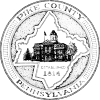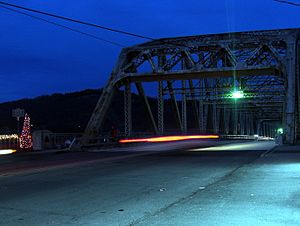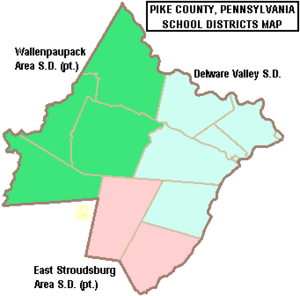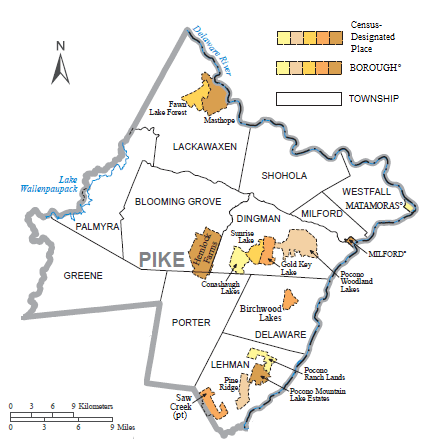Pike County, Pennsylvania facts for kids
Quick facts for kids
Pike County
|
||
|---|---|---|
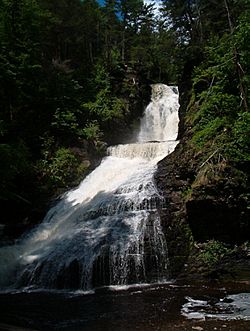
|
||
|
||

Location within the U.S. state of Pennsylvania
|
||
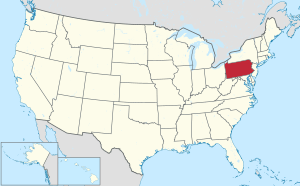 Pennsylvania's location within the U.S. |
||
| Country | ||
| State | ||
| Founded | March 8, 1814 | |
| Named for | Zebulon Pike | |
| Seat | Milford | |
| Largest city | Matamoras | |
| Area | ||
| • Total | 567 sq mi (1,470 km2) | |
| • Land | 545 sq mi (1,410 km2) | |
| • Water | 22 sq mi (60 km2) 3.9%% | |
| Population
(2020)
|
||
| • Total | 58,535 | |
| • Density | 103/sq mi (40/km2) | |
| Time zone | UTC−5 (Eastern) | |
| • Summer (DST) | UTC−4 (EDT) | |
| Congressional district | 8th | |
Pike County is a county in the state of Pennsylvania. In 2020, about 58,535 people lived here. Its main town, or county seat, is Milford. The county is part of the Northeast Pennsylvania area.
Pike County is also part of the larger New York City area. This means it's connected to the big cities of New York, Newark, and Jersey City.
Contents
History
Pike County is named after General Zebulon Pike. It was officially created on March 26, 1814. It was formed from a part of Wayne County, Pennsylvania. Some English settlers had already started living in the area during the colonial times.
The first people to live here for a very long time were the Lenape Native Americans. English colonists called them the Delaware Indians. This was because their land was along the Delaware River.
In 1694, the governor of colony of New York sent Captain Arent Schuyler to check if the French were making friends with Native American tribes. In 1696, the governor allowed people from Ulster County to buy land near the New York border. Their families became the first European settlers in what is now Pike County.
Nicholas Depui was the first European to settle here in 1725. Thomas Quick moved to the Milford area in 1733. Andrew Dingman settled by the Delaware River in 1735, where Dingmans Ferry is today. Early settlers got along well with the Lenape and traded with them.
However, as more settlers arrived, they started using the land differently. This led to disagreements over land. In 1737, a famous event called the Walking Purchase took place. This deal unfairly took more than half of present-day Pike County from the Lenape. When the Lenape realized what had happened, fights broke out between them and the colonists.
In the early 1800s, coal was found near what is now Carbondale. This was very important because after the War of 1812, Britain stopped sending coal to the United States. This caused a fuel shortage in New York City, which was growing fast. To get coal to New York, people planned to build a special railroad. This "gravity railroad" would go from Carbondale to Honesdale. Then, a canal would carry the coal from Honesdale to the Hudson River at Kingston.
New York state approved the canal plan in 1823. Work on the 108-mile (174 km) Delaware and Hudson Canal began in 1825. It was finished in 1828. The canal system, which ended near Kingston, was very successful. But the boats had to cross the Delaware River using a rope ferry. This caused delays and made transportation more expensive.
John Roebling suggested building an aqueduct to carry the canal over the river. Built in 1848, his smart design needed only three supports instead of five. This allowed ice and timber rafts to pass underneath without damaging the bridge. Three more aqueducts were later built for the canal. Roebling's Delaware Aqueduct is still standing today. It might be the oldest suspension bridge in America and is a National Historic Landmark.
For 51 years, coal traveled to New York City using the canal. But then, railroads became popular. They were faster, cheaper, and worked even when canals froze. The New York and Erie Railroad took over from the canal. In 1898, the water route was no longer used.
From 1904 to 1926, Grey Towers in Milford, Pennsylvania was used for summer studies. Students from the Yale School of Forestry came here to learn about forests.
In 1926, the PPL Corporation built a power plant on Wallenpaupack Creek. The village of Wilsonville was moved, and the area became Lake Wallenpaupack. A dam was built to create the lake. About 2,700 workers spent two years building the dam. This project cost over $1 million. Many properties were bought, and farms, barns, and homes were moved or torn down. Also, 17 miles (27 km) of roads and telephone lines were moved. Even a cemetery had to be relocated for the project.
Pike County's rural areas made it a popular place for vacations. Several camps were built near Milford, Pennsylvania. Milford has many old buildings from the late 1800s and early 1900s. These buildings are part of a special Historic District.
Since the late 1900s, Pike County has been the fastest-growing county in Pennsylvania. Between 1990 and 2000, its population grew by 65.2%. It grew another 16.9% between 2000 and 2004. The area has lower taxes and affordable homes. Highways like Interstate 80 and Interstate 84 make it easy to travel to New York City's northern suburbs.
Geography
Pike County covers a total area of 567 square miles (1,469 km²). About 545 square miles (1,412 km²) is land, and 22 square miles (57 km²) (3.9%) is water.
The land quickly rises from the river valley in the east. It then turns into the rolling hills of the Poconos in the west. The highest point is about 2,110 feet (643 m) above sea level. The lowest point is about 340 feet (104 m), where the Bushkill and Delaware rivers meet.
Pike County is the only county in Pennsylvania that borders both New York and New Jersey. Both of these states are east of the Delaware River.
Adjacent counties
- Sullivan County, New York (northeast)
- Orange County, New York (east)
- Sussex County, New Jersey (east)
- Warren County, New Jersey (southeast)
- Monroe County (southwest)
- Wayne County (northwest)
Climate
Pike County has a humid continental climate. This means it has warm summers. Average monthly temperatures in Milford range from 25.6°F (-3.6°C) in January to 71.3°F (21.8°C) in July. In Greentown, temperatures average from 22.8°F (-5.1°C) in January to 68.5°F (20.3°C) in July.
National protected areas
- Delaware Water Gap National Recreation Area (part)
- Middle Delaware National Scenic River (part)
- Upper Delaware Scenic and Recreational River (part)
State protected areas
Major highways
 I-84
I-84 US 6
US 6 US 206
US 206 US 209
US 209 PA 191
PA 191 PA 390
PA 390 PA 402
PA 402 PA 434
PA 434 PA 447
PA 447 PA 507
PA 507 PA 590
PA 590 PA 739
PA 739
Demographics
| Historical population | |||
|---|---|---|---|
| Census | Pop. | %± | |
| 1820 | 2,894 | — | |
| 1830 | 4,843 | 67.3% | |
| 1840 | 3,832 | −20.9% | |
| 1850 | 5,881 | 53.5% | |
| 1860 | 7,155 | 21.7% | |
| 1870 | 8,436 | 17.9% | |
| 1880 | 9,663 | 14.5% | |
| 1890 | 9,412 | −2.6% | |
| 1900 | 8,766 | −6.9% | |
| 1910 | 8,033 | −8.4% | |
| 1920 | 6,818 | −15.1% | |
| 1930 | 7,483 | 9.8% | |
| 1940 | 7,452 | −0.4% | |
| 1950 | 8,425 | 13.1% | |
| 1960 | 9,158 | 8.7% | |
| 1970 | 11,818 | 29.0% | |
| 1980 | 18,271 | 54.6% | |
| 1990 | 27,966 | 53.1% | |
| 2000 | 46,306 | 65.6% | |
| 2010 | 57,369 | 23.9% | |
| 2020 | 58,535 | 2.0% | |
| 2022 (est.) | 60,558 | 5.6% | |
| U.S. Decennial Census | |||
In 2010, there were 57,369 people living in Pike County. About 88.6% were White (not Hispanic). About 6.3% were Black or African American. Around 1.2% were Asian, and 0.5% were Native American. About 1.7% were of two or more races. Also, 10.2% of the people were of Hispanic or Latino background.
In 2000, there were 46,302 people living in the county. There were 17,433 households and 13,022 families. The population density was about 85 people per square mile. The average household had 2.63 people, and the average family had 3.06 people.
The population was spread out by age. About 26.7% were under 18 years old. About 27.7% were between 25 and 44 years old. About 15.2% were 65 years or older. The average age was 40 years.
As of late 2021, the average home value in Pike County was $214,981.
2020 census
| Race | Num. | Perc. |
|---|---|---|
| White (Not Hispanic) | 45,375 | 77.5% |
| Black or African American (Not Hispanic) | 3,027 | 5.2% |
| Native American (Not Hispanic) | 121 | 0.21% |
| Asian (Not Hispanic) | 841 | 1.43% |
| Pacific Islander (Not Hispanic) | 14 | 0.02% |
| Other/Mixed (Not Hispanic) | 2,438 | 4.16% |
| Hispanic or Latino | 6,719 | 11.5% |
Education
Public school districts
There are three school districts in Pike County:
- Delaware Valley School District
- East Stroudsburg Area School District (also in Monroe County)
- Wallenpaupack Area School District (also in Wayne County)
In 2011, residents of Porter Township asked the Pennsylvania Secretary of Education to move their township from the East Stroudsburg Area School District to the Wallenpaupack Area School District. The court heard the appeal in April 2012.
Private schools
- Center for Developmental Disabilities of Pike Co, Ltd. – Milford
- New Life Christian Day School – Matamoras
- Sunshine Academy – Milford
- Kinderhaus Montessori of PA – Milford
Communities
In Pennsylvania, there are different types of towns. These include cities, boroughs, and townships. Here are the boroughs and townships in Pike County:
Boroughs
Townships
- Blooming Grove
- Delaware
- Dingman
- Greene
- Lackawaxen
- Lehman
- Milford
- Palmyra
- Porter
- Shohola
- Westfall
Census-designated places
These are areas that are like towns but are not officially incorporated as boroughs or townships.
- Birchwood Lakes
- Conashaugh Lakes
- Fawn Lake Forest
- Gold Key Lake
- Hemlock Farms
- Masthope
- Pine Ridge
- Pocono Mountain Lake Estates
- Pocono Ranch Lands
- Pocono Woodland Lakes
- Saw Creek
- Sunrise Lake
- Wild Acres Lakes
Population ranking
This table shows the communities in Pike County ranked by their population in 2020.
† county seat
| Rank | City/Town/etc. | Municipal type | Population (2020 Census) |
|---|---|---|---|
| 1 | Saw Creek | CDP | 4,016 |
| 2 | Hemlock Farms | CDP | 3,271 |
| 3 | Pocono Woodland Lakes | CDP | 3,209 |
| 4 | Pine Ridge | CDP | 2,707 |
| 5 | Matamoras | Borough | 2,362 |
| 6 | Gold Key Lake | CDP | 1,830 |
| 7 | Sunrise Lake | CDP | 1,387 |
| 8 | Birchwood Lakes | CDP | 1,386 |
| 9 | Conashaugh Lakes | CDP | 1,294 |
| 10 | Pocono Ranch Lands | CDP | 1,062 |
| 11 | † Milford | Borough | 1,103 |
| 12 | Pocono Mountain Lake Estates | CDP | 842 |
| 13 | Fawn Lake Forest | CDP | 755 |
| 14 | Masthope | CDP | 685 |
Notable natives and residents
Here are some famous people who were born or lived in Pike County:
- James Blish, Damon Knight, Judith Merril and Kate Wilhelm (Mrs. Knight) – all science fiction writers
- Vanessa Carlton (born 1980) – a singer and songwriter
- Zane Grey (1872-1939) – an author known for western stories like Riders of the Purple Sage
- Allyn Joslyn – a stage and screen actor
- Robert Litzenberger – a retired professor from the Wharton School of the University of Pennsylvania
- Frank McCourt – an author
- Charles Sanders Peirce – a philosopher who lived near Milford from 1887 until his death in 1914
- Mary Pickford – a famous silent film actress
- Gifford Pinchot (1865–1946) – the first Chief of the United States Forest Service and a Governor of Pennsylvania
- Al Pitrelli – a guitarist
- Tom Quick – an early settler
- Mary Cole Walling (1838–1925) – a patriot and speaker
- Smoky Joe Wood – a baseball pitcher
- Marie Zimmermann – a designer who made jewelry and metalwork
See also
 In Spanish: Condado de Pike (Pensilvania) para niños
In Spanish: Condado de Pike (Pensilvania) para niños


